Application of Advanced Analytical Techniques in Organic Cultural Heritage: A Case Study of Ancient Architecture Relics in the Palace Museum (Beijing)
Abstract
:1. Introduction
2. Materials and Methods
2.1. Materials
2.2. Sample Pretreatments
2.3. Apparatus and Methods
2.3.1. Microscopic Observation
2.3.2. Colorimetric Measurements
2.3.3. Fourier Transform Infrared Spectroscopy (FTIR)
2.3.4. Scanning Electron Microscopy with Energy Dispersive X-ray Spectroscopy (SEM-EDS)
2.3.5. Ultra-Performance Liquid Chromatography Coupled with Quadrupole Time-of-Flight Mass Spectrometry (UPLC-QTOF MS)
2.3.6. X-ray Diffraction (XRD)
2.3.7. Macro X-ray Fluorescence (MA-XRF) Mapping
2.3.8. Desorption Electrospray Ionization Mass Spectrometry Imaging (DESI-MSI)
3. Results and Discussion
3.1. Cross-Section of the Whole Ceiling Structure
3.2. Fiber Morphology of Each Layer
3.3. Analysis of Characteristic Fabric Layer
3.3.1. Woven Process
3.3.2. Trace Element Mapping Analysis
3.3.3. Industrial Dye Identification by LC-MS
3.3.4. Direct DESI-MSI Analysis
3.4. Coating Composition Analysis from the Outermost Layer
4. Conclusions
Supplementary Materials
Author Contributions
Funding
Institutional Review Board Statement
Informed Consent Statement
Data Availability Statement
Acknowledgments
Conflicts of Interest
References
- Bicchieri, M.; Biocca, P.; Colaizzi, P.; Pinzari, F. Microscopic observations of paper and parchment: The archaeology of small objects. Herit. Sci. 2019, 7, 47. [Google Scholar] [CrossRef] [Green Version]
- Sandu, I.C.A.; Schäfer, S.; Magrini, D.; Bracci, S.; Roque, C.A. Cross-section and staining-based techniques for investigating organic materials in painted and polychrome works of art: A review. Microsc. Microanal. 2012, 18, 860–875. [Google Scholar] [CrossRef] [PubMed]
- Zamboni, C.B.; Redígolo, M.M.; Miura, V.T.; Costa, I.; Nagai, M.L.E.; Salvador, P.A.V.; Giovanni Nogueira da Silva, D. Non-destructive analysis in the study of historical photographs by pXRF and ATR-FTIR spectroscopies. J. Forensic Sci. 2021, 66, 1048–1055. [Google Scholar] [CrossRef] [PubMed]
- Tamburini, D.; Breitung, E.; Mori, C.; Kotajima, T.; Clarke, M.L.; McCarthy, B. Exploring the transition from natural to synthetic dyes in the production of 19th-century Central Asian ikat textiles. Herit. Sci. 2020, 8, 114. [Google Scholar] [CrossRef]
- Rosi, F.; Cartechini, L.; Sali, D.; Miliani, C. Recent trends in the application of Fourier Transform Infrared (FT-IR) spectroscopy in Heritage Science: From micro- to non-invasive FT-IR. Phys. Sci. Rev. 2019, 4, 20180006. [Google Scholar] [CrossRef]
- Gabrieli, F.; Rosi, F.; Vichi, A.; Cartechini, L.; Pensabene Buemi, L.; Kazarian, S.G.; Miliani, C. Revealing the nature and distribution of metal carboxylates in Jackson pollock’s Alchemy (1947) by micro-attenuated total reflection FT-IR spectroscopic imaging. Anal. Chem. 2017, 89, 1283–1289. [Google Scholar] [CrossRef]
- Badillo Sanchez, D.; Chelazzi, D.; Giorgi, R.; Cincinelli, A.; Baglioni, P. Characterization of the secondary structure of degummed Bombyx mori silk in modern and historical samples. Polym. Degrad. Stab. 2018, 157, 53–62. [Google Scholar] [CrossRef]
- Marchetti, A.; Beltran, V.; Nuyts, G.; Borondics, F.; De Meyer, S.; Van Bos, M.; Jaroszewicz, J.; Otten, E.; Debulpaep, M.; De Wael, K. Novel optical photothermal infrared (O-PTIR) spectroscopy for the noninvasive characterization of heritage glass-metal objects. Sci. Adv. 2022, 8, eabl6769. [Google Scholar] [CrossRef]
- de Winter, N.J.; Sinnesael, M.; Makarona, C.; Vansteenberge, S.; Claeys, P. Trace element analyses of carbonates using portable and micro-X-ray fluorescence: Performance and optimization of measurement parameters and strategies. J. Anal. At. Spectrom. 2017, 32, 1211–1223. [Google Scholar] [CrossRef]
- Vanhoof, C.; Bacon, J.R.; Fittschen, U.E.A.; Vincze, L. Atomic spectrometry update–A review of advances in X-ray fluorescence spectrometry and its special applications. J. Anal. At. Spectrom. 2021, 36, 1797–1812. [Google Scholar] [CrossRef]
- Watts, K.E.; Lagalante, A.F. Method development for binding media analysis in painting cross-sections by desorption electrospray ionization mass spectrometry. Rapid Commun. Mass Spectrom. 2018, 32, 1324–1330. [Google Scholar] [CrossRef] [PubMed]
- Takáts, Z.; Wiseman, J.M.; Gologan, B.; Cooks, R.G. Mass spectrometry sampling under ambient conditions with desorption electrospray ionization. Science 2004, 306, 471–473. [Google Scholar] [CrossRef] [PubMed] [Green Version]
- Aucouturier, M.; Darque-Ceretti, E. The surface of cultural heritage artefacts: Physicochemical investigations for their knowledge and their conservation. Chem. Soc. Rev. 2007, 36, 1605–1621. [Google Scholar] [CrossRef] [PubMed]
- Gutierrez, S.M.V.; He, Y.; Cao, Y.; Stone, D.; Walsh, Z.; Malhotra, R.; Chen, H.-L.; Chang, C.-H.; Robinson, S.C. Feasibility and surface evaluation of the pigment from Scytalidium cuboideum for inkjet printing on textiles. Coatings 2019, 9, 266. [Google Scholar] [CrossRef] [Green Version]
- Sabatini, F.; Eis, E.; Degano, I.; Thoury, M.; Bonaduce, I.; Lluveras-Tenorio, A. The issue of eosin fading: A combined spectroscopic and mass spectrometric approach applied to historical lakes. Dyes Pigments 2020, 180, 108436. [Google Scholar] [CrossRef]
- Ma, Y.; Lei, Y.; Wang, S. Composition and manufacturing techniques of wallpaper in the Bower of Purest Jade (Yu cuixuan), The Forbidden City, Beijing, China. Stud. Conserv. 2014, 59, S107–S110. [Google Scholar] [CrossRef]
- Shi, J.; Li, T. Technical investigation of 15th and 19th century Chinese paper currencies: Fiber use and pigment identification. J. Raman Spectrosc. 2013, 44, 892–898. [Google Scholar] [CrossRef]
- Wouters, J.; Grzywacz, C.M.; Claro, A. A comparative investigation of hydrolysis methods to analyze natural organic dyes by HPLC-PDA-nine methods, twelve biological sources, ten dye classes, dyed yarns, pigments and paints. Stud. Conserv. 2011, 56, 231–249. [Google Scholar] [CrossRef]
- Iannaccone, R.; Antona, A.; Magri, D.; Canu, A.; Marceddu, S.; Brunetti, A. First characterization of a Bronze Age textile fibre from Sardinia (Italy). Spectrochim. Acta A 2022, 265, 120398. [Google Scholar] [CrossRef]
- Ji, L. Practicing benevolent governance based on perfect self-cultivation. Archit. J. 2018, 601, 42–46. [Google Scholar]
- Kizil, R.; Irudayaraj, J.; Seetharaman, K. Characterization of irradiated starches by using FT-Raman and FTIR spectroscopy. J. Agric. Food Chem. 2002, 50, 3912–3918. [Google Scholar] [CrossRef] [PubMed]
- Wang, J. Papermaking Raw Materials of China: An Atlas of Micrographs and the Characteristics of Fibers; China Light Industry Press: Beijing, China, 1999. [Google Scholar]
- Ma, Y.; Ji, L. Study of Biaohu paper in Yan Xi Tang of Yang Xin Dian of the Palace Museum. Sci. Conserv. Archaeol. 2021, 33, 61–68. [Google Scholar]
- Thibodeaux, D.P.; Rajasekaran, K. Development of new reference standards for cotton fiber maturity. J. Cotton Sci. 1999, 3, 188–193. [Google Scholar]
- Ding, Y.; Ji, L. Ceiling wooden pane study of indoor papering in Yangxin Hall area. Tradit. Chin. Archit. Gard. 2017, 135, 81–85. [Google Scholar]
- Broadbent, A.D. Basic Principles of Textile Coloration, 2nd ed.; Society of Dyers and Colourists: Yorkshire, UK, 2001. [Google Scholar]
- Newman, R. Chromium oxide greens. In Artists’ Pigments: A Handbook of Their History and Characteristics; FitzHugh, E.W., Ed.; Oxford University Press: New York, NY, USA, 1997; Volume 3. [Google Scholar]
- Laver, M. Titanium dioxide whites. In Artists’ Pigments: A Handbook of Their History and Characteristics; FitzHugh, E.W., Ed.; Oxford University Press: New York, NY, USA, 1997; Volume 3. [Google Scholar]
- van Bommel, M.R.; Berghe, I.V.; Wallert, A.M.; Boitelle, R.; Wouters, J. High-performance liquid chromatography and non-destructive three-dimensional fluorescence analysis of early synthetic dyes. J. Chromatogr. A 2007, 1157, 260–272. [Google Scholar] [CrossRef]
- Bradford, F. Colour Index, 1st ed.; Society of Dyers and Colourists: Yorkshire, UK, 1971. [Google Scholar]
- Tamburini, D.; Shimada, C.M.; McCarthy, B. The molecular characterization of early synthetic dyes in E. Knecht et al’s textile sample book “A Manual of Dyeing” (1893) by high performance liquid chromatography-Diode array detector-Mass spectrometry (HPLC-DAD-MS). Dyes Pigments 2021, 190, 109286. [Google Scholar] [CrossRef]
- López-Montes, A.M.; Dupont, A.-L.; Desmazières, B.; Lavédrine, B. Identification of synthetic dyes in early colour photographs using capillary electrophoresis and electrospray ionisation-mass spectrometry. Talanta 2013, 114, 217–226. [Google Scholar] [CrossRef] [Green Version]
- Hu, Z.; Qi, P.; Wang, N.; Zhu, Q.; Lin, Z.; Chen, Y.; Mao, X.; Jiang, J.; Li, C. Simultaneous determination of multiclass illegal dyes with different acidic-basic properties in foodstuffs by LC-MS/MS via polarity switching mode. Food Chem. 2020, 309, 125745. [Google Scholar] [CrossRef]
- de Melo, J.S.S. The molecules of colour. Photochemistry 2018, 45, 68–100. [Google Scholar]
- Sabatini, F.; Degano, I.; Colombini, M.P. Development of a method based on high-performance liquid chromatography coupled with diode array, fluorescence, and mass spectrometric detectors for the analysis of eosin at trace levels. Sep. Sci. Plus 2020, 3, 207–215. [Google Scholar] [CrossRef]
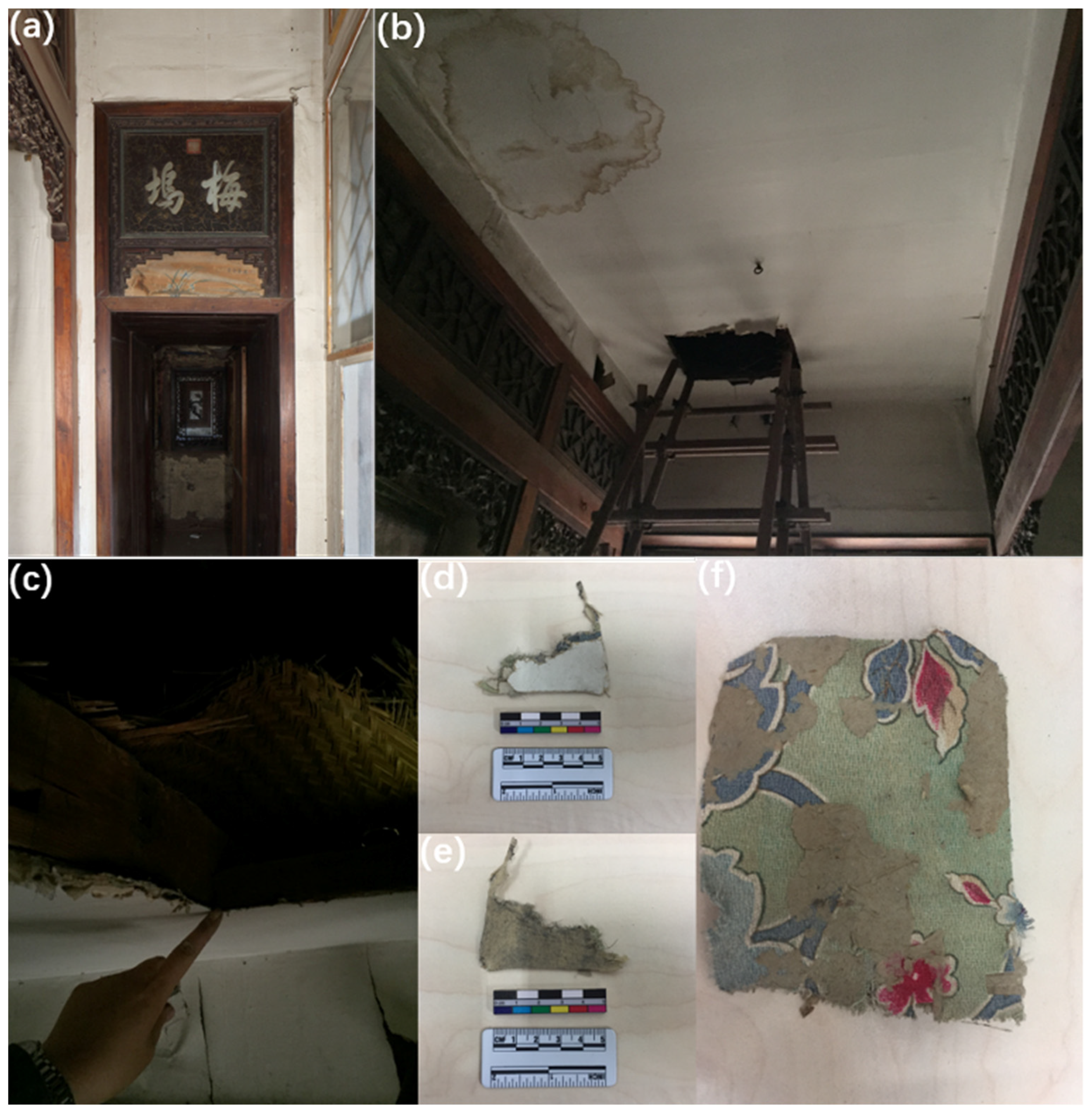

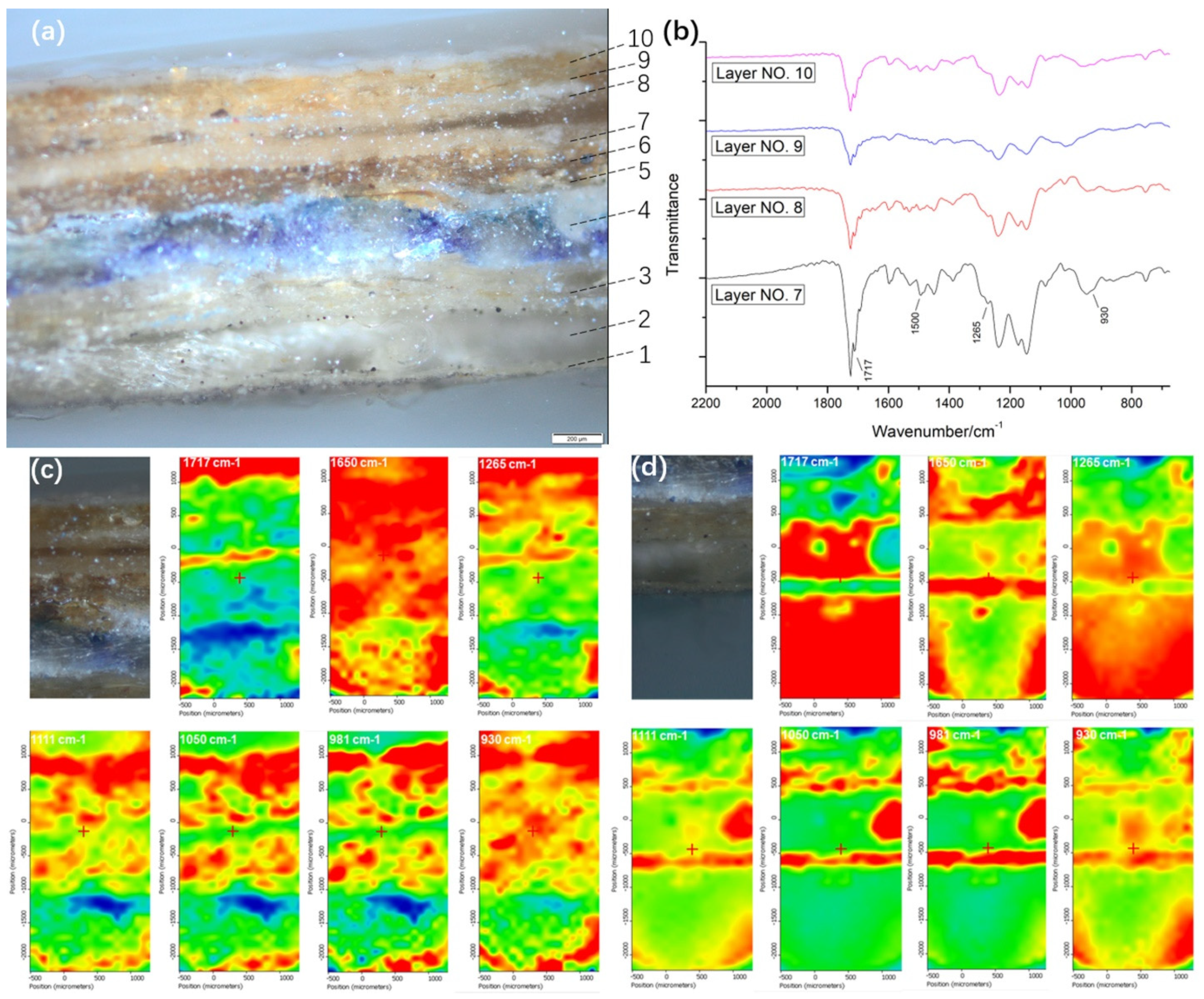

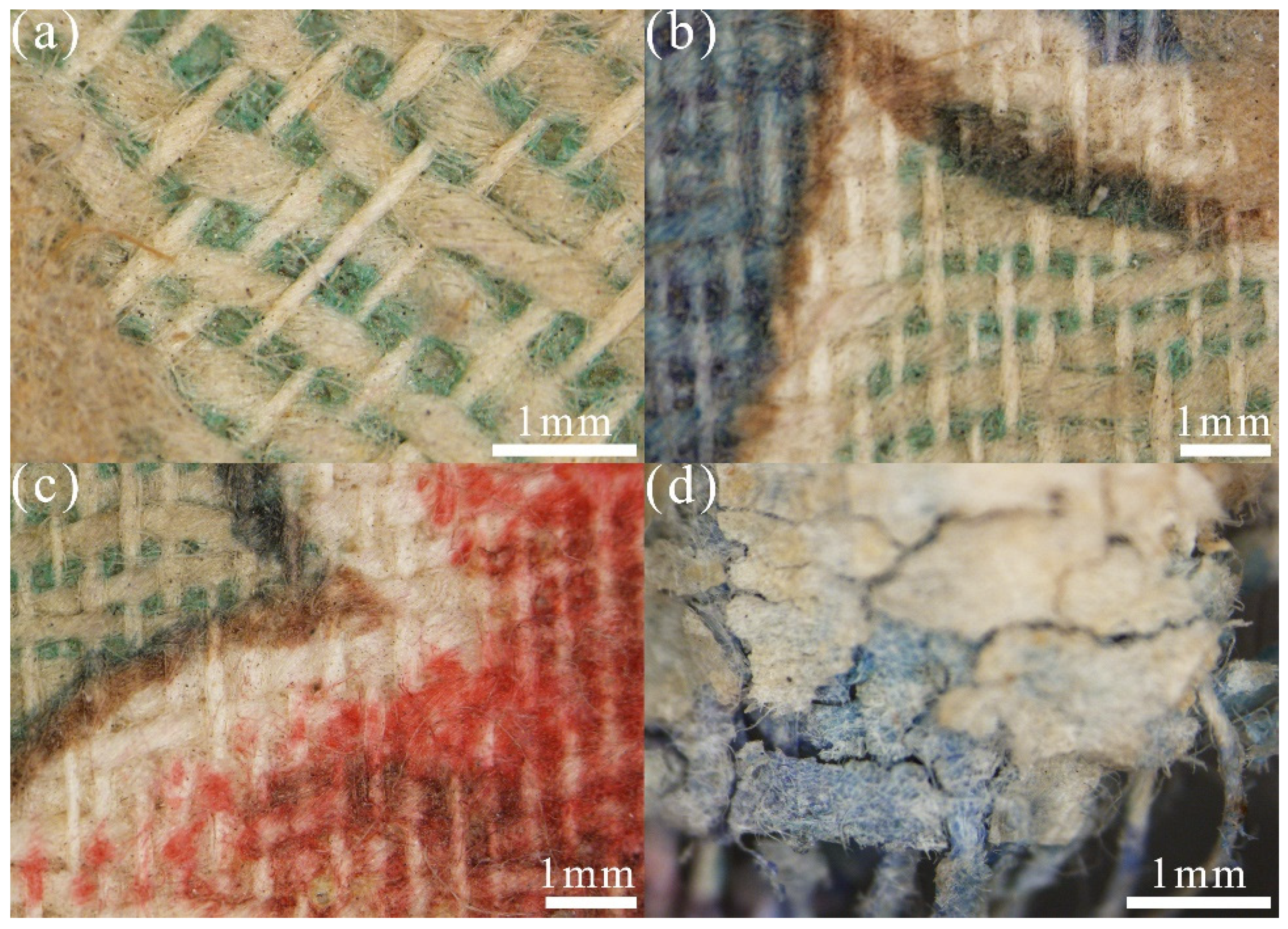

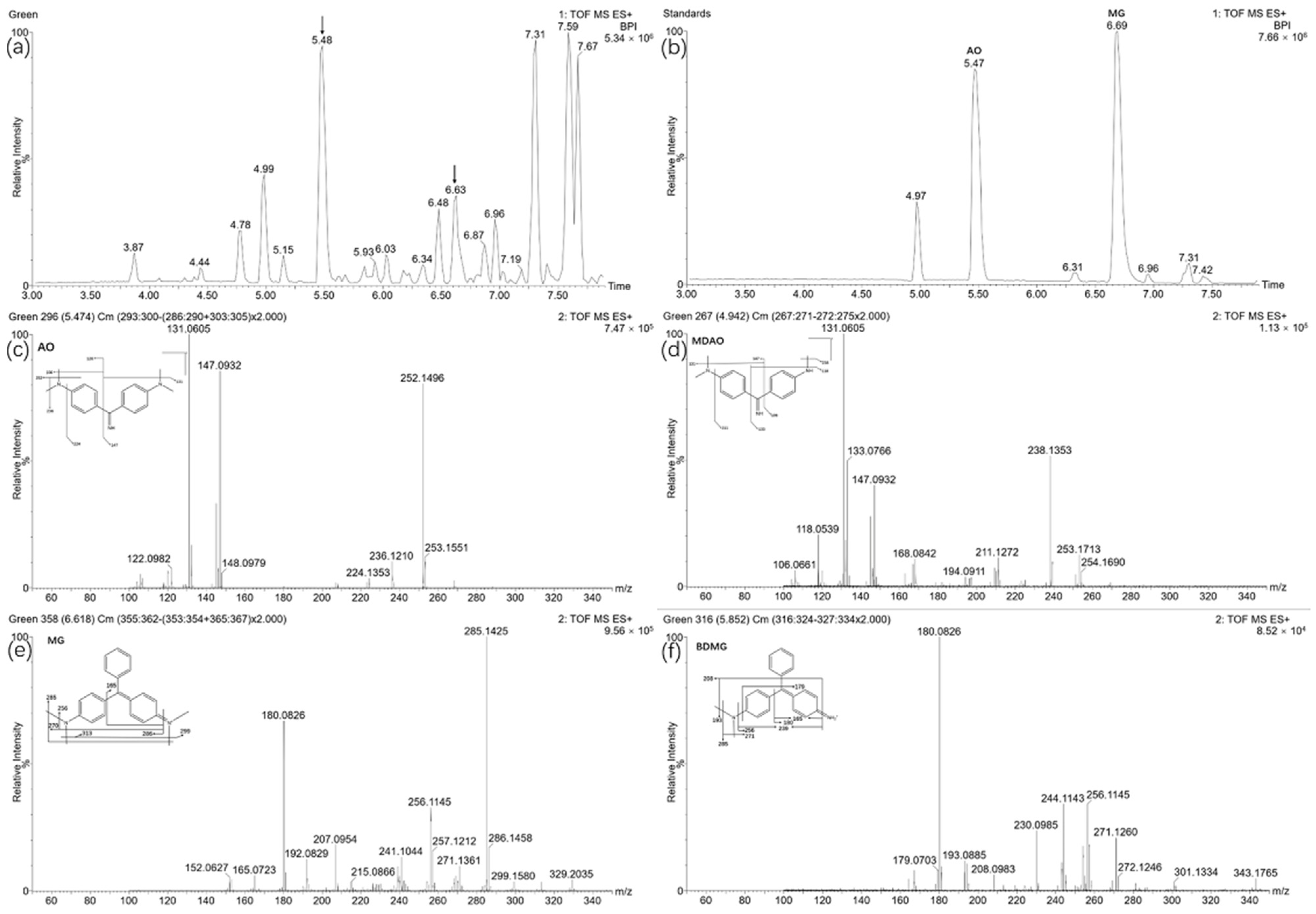
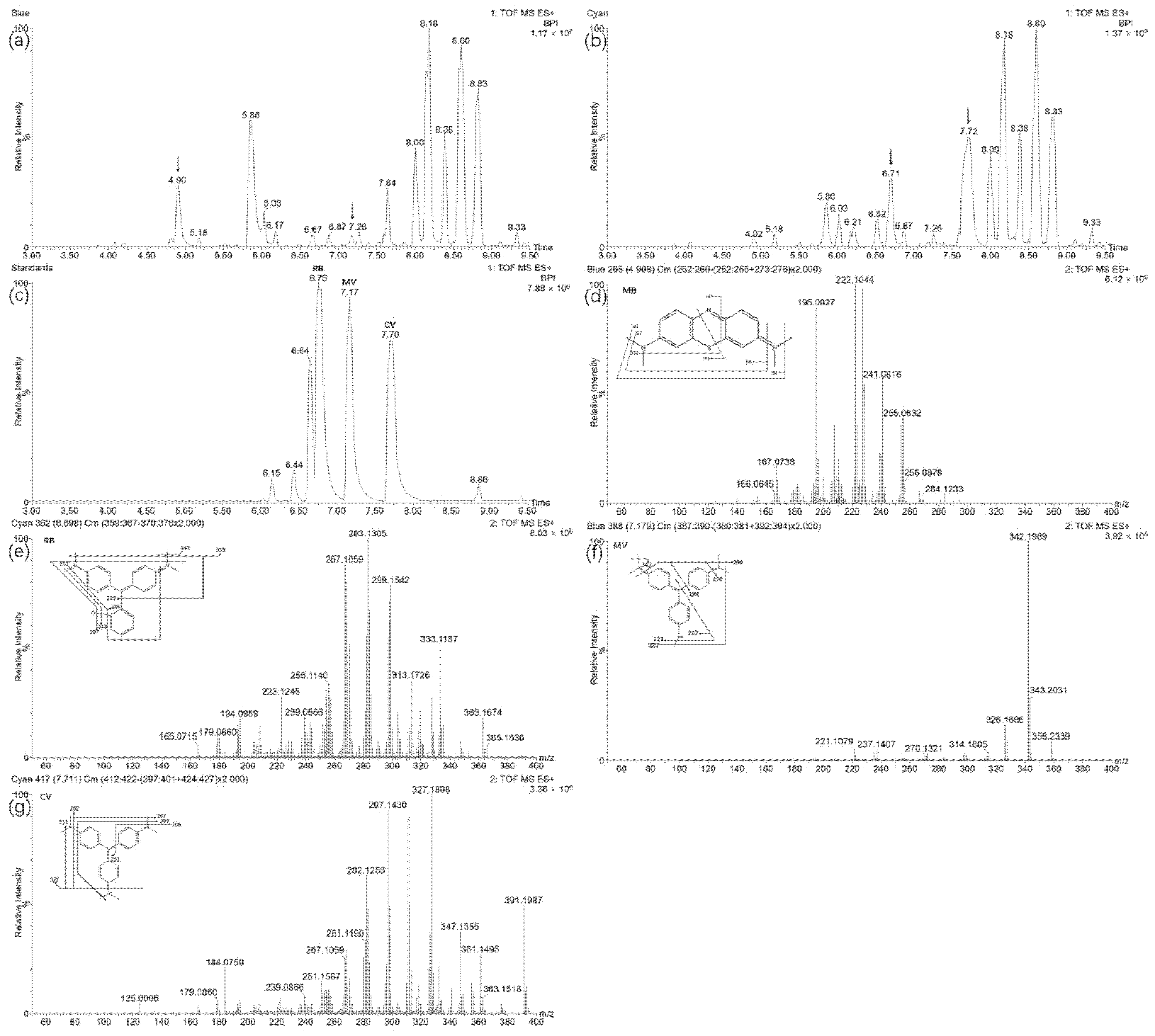
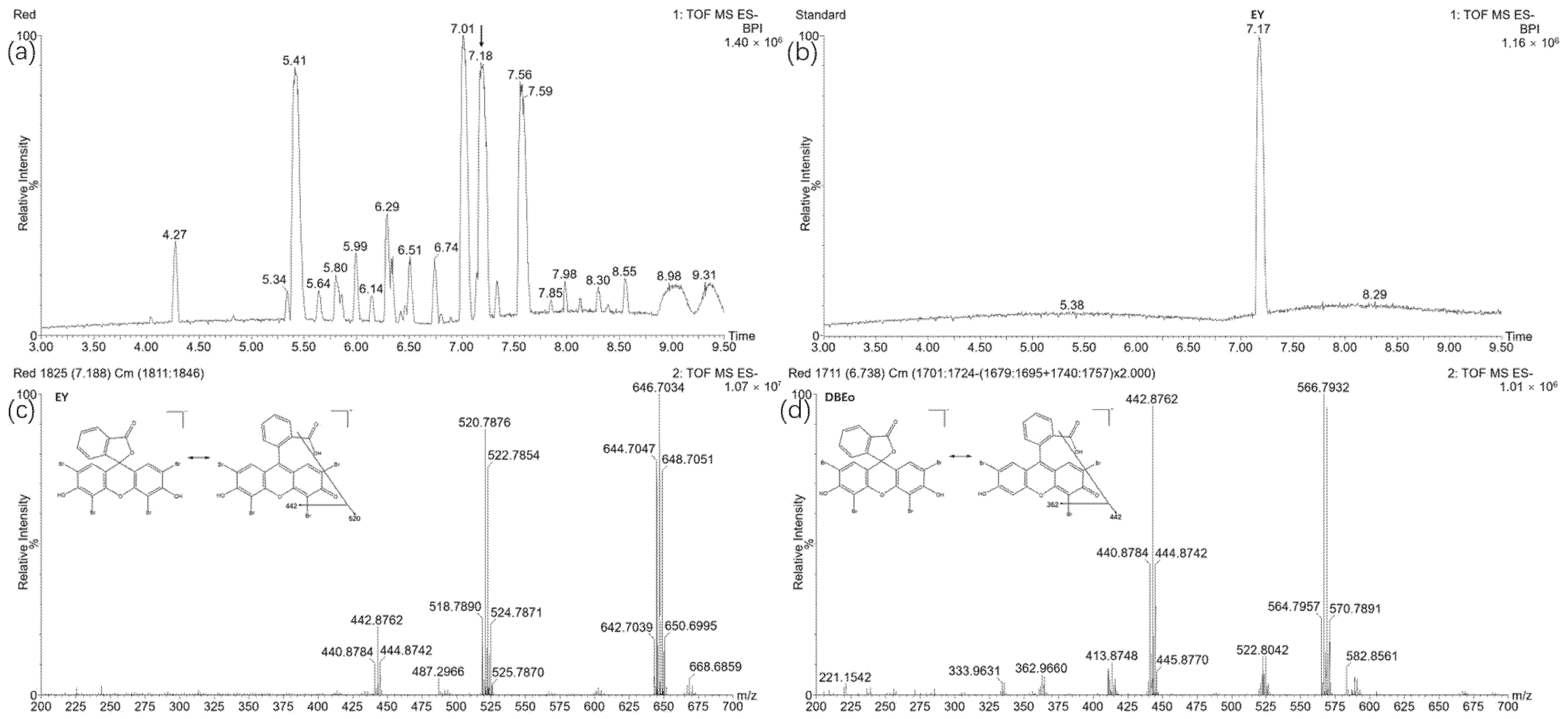
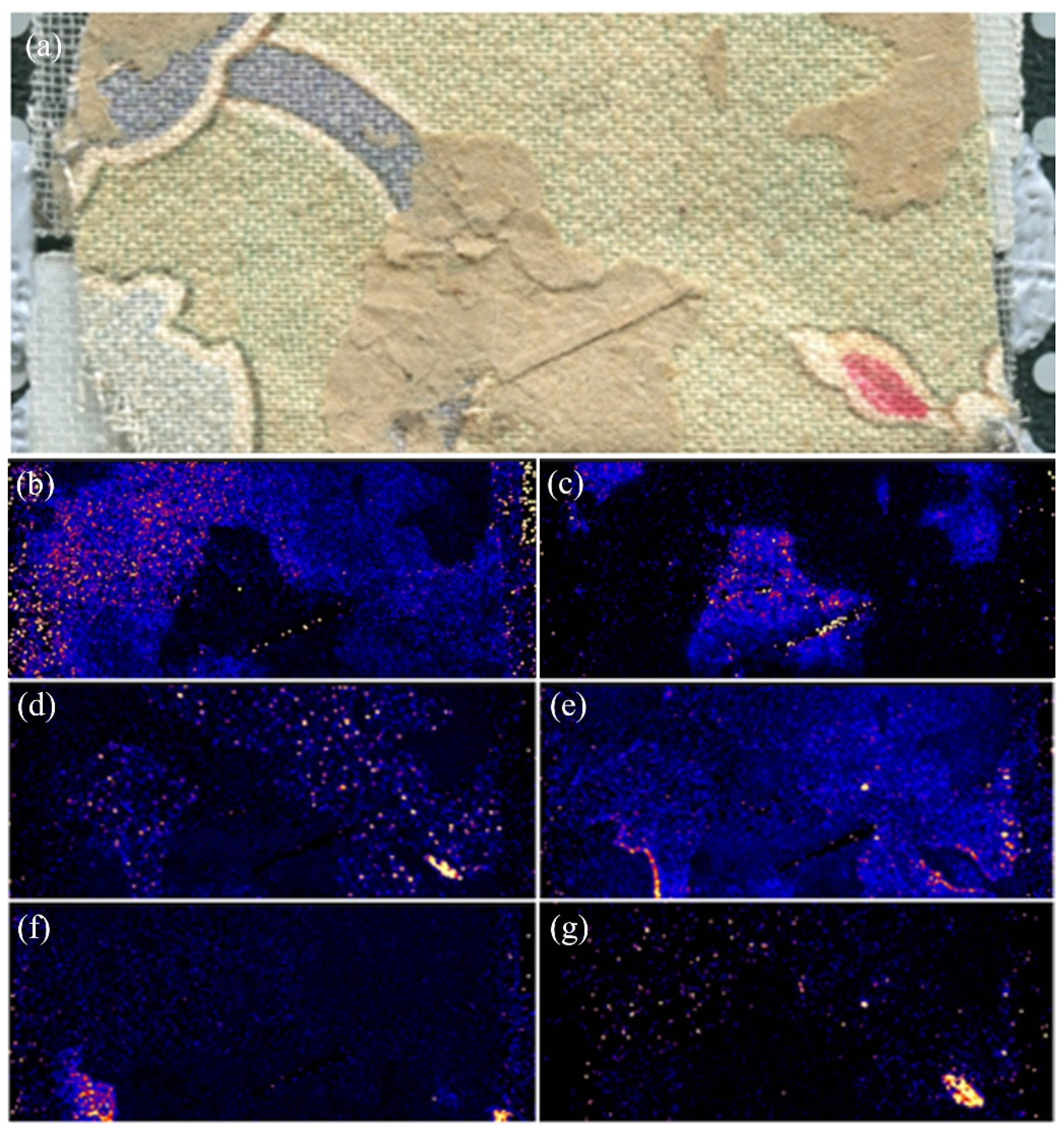
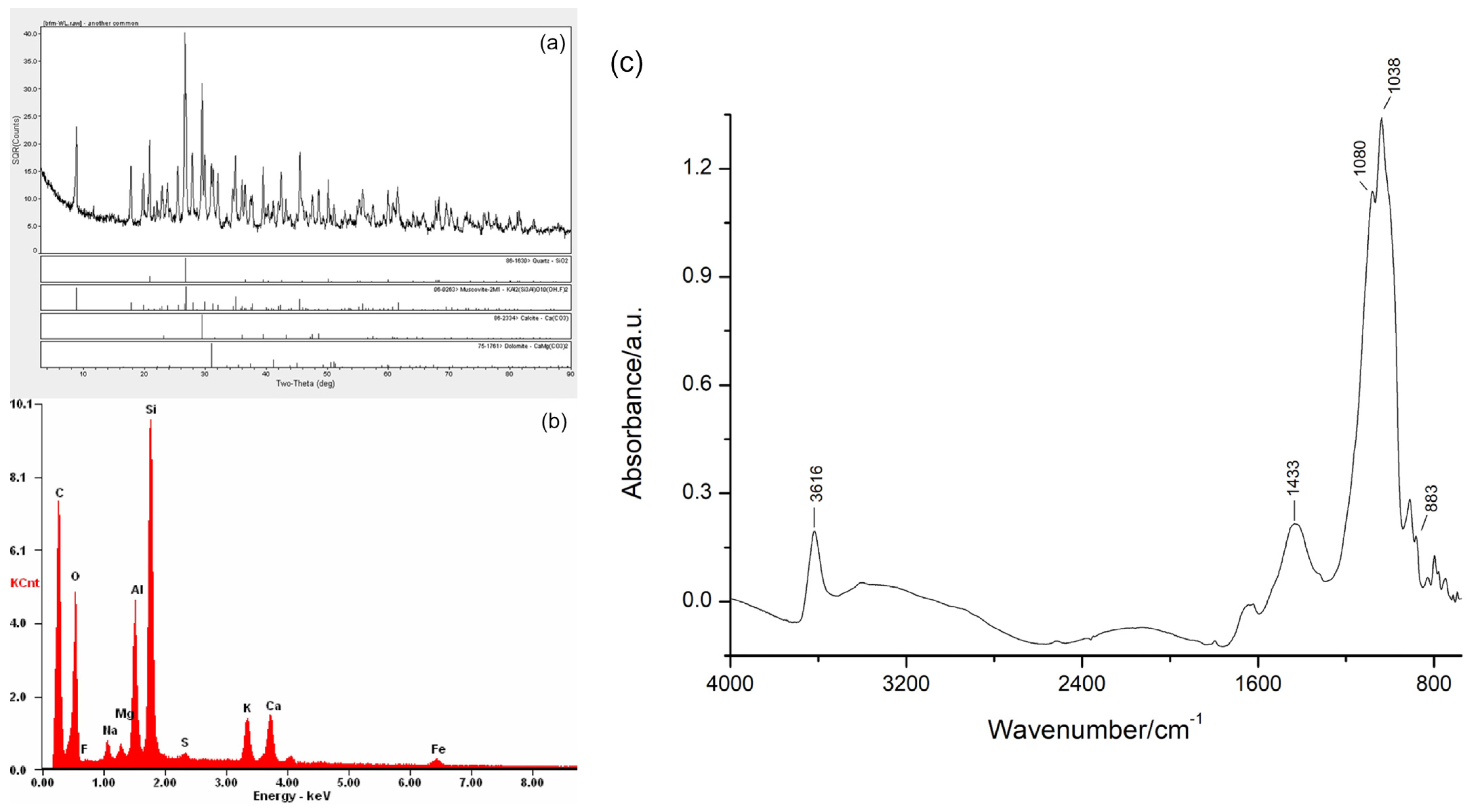
| Ink Color | Industrial Dyes | Synonym | Color Index (C.I.) | Abbrev. | Formula | Adducts | Observed Pseudo-Molecular Ion (m/z) | Mass Error (ppm) | RT/min | Fragment Ion (m/z) | Earliest Synthetic Time [30] |
|---|---|---|---|---|---|---|---|---|---|---|---|
| Green | Auramine O | Basic Yellow 2 | 41,000 | AO | C17H22ClN3 | M-Cl | 268 (+) | 0.7 | 5.48 | 252/147/131 | 1883 |
| Mono-demethylated AO | -- | -- | MDAO | C16H20ClN3 | M-Cl | 254 (+) | 0.5 | 4.99 | 238/147/133 | -- | |
| Malachite Green | Basic Green 4 | 42,000 | MG | C23H25ClN2 | M-Cl | 329 (+) | −0.3 | 6.63 | 313/285/192 | 1877 | |
| Bis-demethylated MG | -- | -- | BDMG | C21H21ClN2 | M-Cl | 301 | 2.5 | 5.93 | 285/256/180 | -- | |
| Blue | Methylene Blue | Basic Blue 9 | 52,015 | MB | C16H18ClN3S | M-Cl | 284 (+) | −0.8 | 4.90 | 268/241/267 | 1876 |
| Methyl Violet | Basic Violet 1 | 42,535 | MV | C24H28ClN3 | M-Cl | 358 (+) | 0.1 | 7.17 | 342/326/221 | 1861 | |
| Cyan | Rhoduline Blue | Basic Blue 1 | 42,025 | RB | C23H24Cl2N2 | M-Cl | 363 (+) | −0.1 | 6.71 | 299/283/267 | 1896 |
| Crystal Violet | Basic Violet 3 | 42,555 | CV | C25H30ClN3 | M-Cl | 372 (+) | 0.1 | 7.72 | 356/340 | 1883 | |
| Red | Eosin Y | Acid Red 87 | 45,380 | EY | C20H8Br4O5 | M-H | 646 (−) | 0.1 | 7.18 | 520/442 | 1872 |
| Mono-debrominated EY | -- | -- | DBEo | C20H9Br3O5 | M-H | 566 (−) | −1.0 | 6.74 | 442/362 | -- |
Publisher’s Note: MDPI stays neutral with regard to jurisdictional claims in published maps and institutional affiliations. |
© 2022 by the authors. Licensee MDPI, Basel, Switzerland. This article is an open access article distributed under the terms and conditions of the Creative Commons Attribution (CC BY) license (https://creativecommons.org/licenses/by/4.0/).
Share and Cite
Wei, L.; Ma, Y.; Guo, Z.; Ding, J.; Jin, G.; Gu, A.; Lei, Y. Application of Advanced Analytical Techniques in Organic Cultural Heritage: A Case Study of Ancient Architecture Relics in the Palace Museum (Beijing). Coatings 2022, 12, 636. https://doi.org/10.3390/coatings12050636
Wei L, Ma Y, Guo Z, Ding J, Jin G, Gu A, Lei Y. Application of Advanced Analytical Techniques in Organic Cultural Heritage: A Case Study of Ancient Architecture Relics in the Palace Museum (Beijing). Coatings. 2022; 12(5):636. https://doi.org/10.3390/coatings12050636
Chicago/Turabian StyleWei, Le, Yue Ma, Zhimou Guo, Junjie Ding, Gaowa Jin, An Gu, and Yong Lei. 2022. "Application of Advanced Analytical Techniques in Organic Cultural Heritage: A Case Study of Ancient Architecture Relics in the Palace Museum (Beijing)" Coatings 12, no. 5: 636. https://doi.org/10.3390/coatings12050636
APA StyleWei, L., Ma, Y., Guo, Z., Ding, J., Jin, G., Gu, A., & Lei, Y. (2022). Application of Advanced Analytical Techniques in Organic Cultural Heritage: A Case Study of Ancient Architecture Relics in the Palace Museum (Beijing). Coatings, 12(5), 636. https://doi.org/10.3390/coatings12050636







